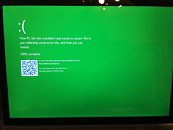Apr 10th, 2025 04:23 EDT
change timezone
Latest GPU Drivers
New Forum Posts
- [Update] FanControl (and other different monitoring software) blocked by Defender due to Winring0 vulnerability (2)
- Do you use Linux? (572)
- Help with updating firmware on a AOC Agon Pro OLED monitor, says I need Install Tool (3)
- HP EliteDesk 800 G2 SFF CPU support (2)
- Anyone know where to get driver updates / backdates for TUF A15? (4)
- EK Quantum Velocity intel to amd conversion (13)
- How is the Gainward Phoenix Model in terms of quality? (0)
- ## [Golden Sample] RTX 5080 – 3300 MHz @ 1.020 V (Stock Curve) – Ultra-Stable & Efficient (44)
- hp envy 15 rtx 2060 max-q stock vbios (1)
- (Some of) What I'd like to See From a Final Fantasy IX Remake (10)
Popular Reviews
- The Last Of Us Part 2 Performance Benchmark Review - 30 GPUs Compared
- ASRock Z890 Taichi OCF Review
- MCHOSE L7 Pro Review
- Sapphire Radeon RX 9070 XT Pulse Review
- PowerColor Radeon RX 9070 Hellhound Review
- Upcoming Hardware Launches 2025 (Updated Apr 2025)
- Sapphire Radeon RX 9070 XT Nitro+ Review - Beating NVIDIA
- Acer Predator GM9000 2 TB Review
- ASUS GeForce RTX 5080 Astral OC Review
- UPERFECT UStation Delta Max Review - Two Screens In One
Controversial News Posts
- NVIDIA GeForce RTX 5060 Ti 16 GB SKU Likely Launching at $499, According to Supply Chain Leak (174)
- MSI Doesn't Plan Radeon RX 9000 Series GPUs, Skips AMD RDNA 4 Generation Entirely (146)
- Microsoft Introduces Copilot for Gaming (124)
- AMD Radeon RX 9070 XT Reportedly Outperforms RTX 5080 Through Undervolting (119)
- NVIDIA Reportedly Prepares GeForce RTX 5060 and RTX 5060 Ti Unveil Tomorrow (115)
- Over 200,000 Sold Radeon RX 9070 and RX 9070 XT GPUs? AMD Says No Number was Given (100)
- Nintendo Switch 2 Launches June 5 at $449.99 with New Hardware and Games (99)
- Nintendo Confirms That Switch 2 Joy-Cons Will Not Utilize Hall Effect Stick Technology (99)
News Posts matching #bsod
Return to Keyword Browsing
Nintendo Wii U Memory Failures Investigated by Homebrew Community, Hynix Chips in the Spotlight
The homebrew and modification community has delved deeper into the recent bout of bricked Nintendo Wii U consoles, unlucky owners are seeing their systems throwing up error codes that indicate an internal memory failure. As covered on TPU almost two weeks ago, it was speculated that leaving a Wii U in a long-term state of unuse was a root cause of the problem. It is now theorized that a simple choice of memory chip is the real issue behind the corruptions, and not a case of leaving your unplugged Wii U stashed in a box somewhere.
An online database has been established on hackmd.io, and a member is collecting hard data from Wii U owners across various online communities and sources. Early indications show that consoles fitted with a Hynix eMMC are leading the pack in terms of number of system failures, Samsung-equipped models are placed in a distant second place, and the Toshiba variant is reported as having zero problems.
An online database has been established on hackmd.io, and a member is collecting hard data from Wii U owners across various online communities and sources. Early indications show that consoles fitted with a Hynix eMMC are leading the pack in terms of number of system failures, Samsung-equipped models are placed in a distant second place, and the Toshiba variant is reported as having zero problems.

Long Term Nintendo Wii U Owners Experiencing Bricked Systems
It has been reported by multiple users across several online communities that their Wii U consoles are no longer functioning properly. The error codes 160-0103 and 160-2155 are the dreaded indicators of memory corruption. It has been discovered that the NAND Flash within the Wii U's internal eMMC is prone to failure. According to details gleaned from teardowns of the console's hardware, Nintendo has implemented either Toshiba or Samsung flash storage boards for the various revisions of the console. There has been an uptick in the rate of bricked Wii U consoles across recent months, but the problems seem to have occurred as far back as 2015, according to archived posts on the GBA Temp forum. It is speculated that leaving the Wii U inactive for long periods of time can lead to the memory corruption issues.
Anti-cheat Software Runs Amok Causing System Crashes in Windows 10 Insider Previews
In what is likely to cause some hand wringing or chuckles depending on upon your personality, Microsoft's Windows 10 Insider Preview Slow Ring (beta versions of the OS) has not seen a new release in months. This is due to a common Anti-cheat software running amok and causing GSODs (replacement for BSODs in preview builds). The problem itself has existed for a few months and needs to be fixed by the creators of the software as noted by Chief of the Windows Insider program, Dona Sarkar, on twitter. Apparently, this isn't something Microsoft can fix due to how the software itself functions. Essentially the unspecified anti-cheat software runs in kernel mode and tampers with various aspects of the OS that it is not supposed to tamper with. While it is possible, the software is using allowed hooks in order to function. It is also possible that in the process it is damaging kernel data structures and code. This situation is likely to stir up debate on how effective anti-cheat software is considering it seldom seems to stop determined cheaters and as of now is causing the OS crash and is proving to be a thorn in Microsoft's side.
Still, this has more ramifications than just some system crashes or a software company that needs to edit some code. It directly results in Microsoft having to delay Preview releases. Since these Slow Ring builds can't be tested or validated. Pair that with the fact Microsoft's testing of Windows 10 builds is already considered lackluster with many bugs and issues going unresolved and you end up with a rather grim situation. After all, it was only a few short months ago that the October 2018 update was released after suffering numerous problems and delays. If issues like that continue, it seems the April 2019 update could be delayed as well. To avoid this and to get something done, Microsoft will be pushing out a Slow Ring build to systems that do not have the offending anti-cheat software. Better late than never but you would have thought that this solution would have been implemented sooner.
Still, this has more ramifications than just some system crashes or a software company that needs to edit some code. It directly results in Microsoft having to delay Preview releases. Since these Slow Ring builds can't be tested or validated. Pair that with the fact Microsoft's testing of Windows 10 builds is already considered lackluster with many bugs and issues going unresolved and you end up with a rather grim situation. After all, it was only a few short months ago that the October 2018 update was released after suffering numerous problems and delays. If issues like that continue, it seems the April 2019 update could be delayed as well. To avoid this and to get something done, Microsoft will be pushing out a Slow Ring build to systems that do not have the offending anti-cheat software. Better late than never but you would have thought that this solution would have been implemented sooner.

BSODs from Meltdown and Spectre Firmware Updates Are Spreading Like the Plague
Have you ever taken your car to the mechanic shop to fix one thing but end up breaking another? Well, that's how Intel CPU owners are feeling right now. Intel previously confirmed that their Meltdown and Spectre firmware updates are causing irritating reboots on systems with Broadwell and Haswell processors. After analyzing the latest customer reports, they are acknowledging that the updates are also causing BSODs on the Kaby Lake, Skylake, Ivy Bridge, and Sandy Bridge platforms. This shouldn't come as a shocker considering how both the Meltdown and Spectre exploits affect Intel processors over the past 20 years. The possibility of all platforms suffering from the same side effects is extremely high. Fear not, though, as Intel is already working on an updated microcode to fix the constant system reboots. Motherboard vendors should have the beta microcode for validation by next week. Expect a new BIOS revision for your motherboard soon.

SandForce BSOD Firmware Bug: Fix Finally Available
Finally a fix for the BSOD/disconnect bug that has been plaguing users for months is available for SF-2200 based SSDs. OCZ uses these, has been testing this new firmware for several weeks and now believes that it's fit for release. The new firmware is at version 2.15 for OCZ drives and 3.3.2 for drives that SandForce's standard numbering system. As with any firmware update, it should be used cautiously, all data backed up and perhaps used on a non-mission critical Windows install for a while, for confidence. Note that there may be more unresolved issues and new ones introduced.
Apr 10th, 2025 04:23 EDT
change timezone
Latest GPU Drivers
New Forum Posts
- [Update] FanControl (and other different monitoring software) blocked by Defender due to Winring0 vulnerability (2)
- Do you use Linux? (572)
- Help with updating firmware on a AOC Agon Pro OLED monitor, says I need Install Tool (3)
- HP EliteDesk 800 G2 SFF CPU support (2)
- Anyone know where to get driver updates / backdates for TUF A15? (4)
- EK Quantum Velocity intel to amd conversion (13)
- How is the Gainward Phoenix Model in terms of quality? (0)
- ## [Golden Sample] RTX 5080 – 3300 MHz @ 1.020 V (Stock Curve) – Ultra-Stable & Efficient (44)
- hp envy 15 rtx 2060 max-q stock vbios (1)
- (Some of) What I'd like to See From a Final Fantasy IX Remake (10)
Popular Reviews
- The Last Of Us Part 2 Performance Benchmark Review - 30 GPUs Compared
- ASRock Z890 Taichi OCF Review
- MCHOSE L7 Pro Review
- Sapphire Radeon RX 9070 XT Pulse Review
- PowerColor Radeon RX 9070 Hellhound Review
- Upcoming Hardware Launches 2025 (Updated Apr 2025)
- Sapphire Radeon RX 9070 XT Nitro+ Review - Beating NVIDIA
- Acer Predator GM9000 2 TB Review
- ASUS GeForce RTX 5080 Astral OC Review
- UPERFECT UStation Delta Max Review - Two Screens In One
Controversial News Posts
- NVIDIA GeForce RTX 5060 Ti 16 GB SKU Likely Launching at $499, According to Supply Chain Leak (174)
- MSI Doesn't Plan Radeon RX 9000 Series GPUs, Skips AMD RDNA 4 Generation Entirely (146)
- Microsoft Introduces Copilot for Gaming (124)
- AMD Radeon RX 9070 XT Reportedly Outperforms RTX 5080 Through Undervolting (119)
- NVIDIA Reportedly Prepares GeForce RTX 5060 and RTX 5060 Ti Unveil Tomorrow (115)
- Over 200,000 Sold Radeon RX 9070 and RX 9070 XT GPUs? AMD Says No Number was Given (100)
- Nintendo Switch 2 Launches June 5 at $449.99 with New Hardware and Games (99)
- Nintendo Confirms That Switch 2 Joy-Cons Will Not Utilize Hall Effect Stick Technology (99)








